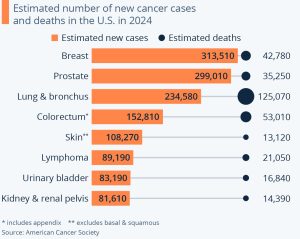Data published by the American Cancer Society shows that there are expected to be 100,640 new cases of melanoma of the skin in 2024 (a majority of the 108,270 overall skin cancer cases), and a total of 8,290 deaths from the disease (out of the 13,120 total skin cancer deaths).
Breast cancer, prostate cancer and lung cancer are expected to continue to be the most common cancers in the U.S. in 2024, with the latter expected to claim more than 125,000 lives.

Pancreatic cancer and liver cancer, both not included in this list due to their lower numbers of expected cases (66,440; 41,630), stand out for their high death rates per cases (51,750 deaths predicted in 2024 for pancreatic cancer; 29,840 deaths predicted for cancer of the liver & intrahepatic bile duct).
Chances of getting melanoma of the skin
Data published by the American Cancer Society shows that the risk of skin cancer is higher among older age groups and that men are more likely to develop melanoma of the skin than women – although women under the age of 30 buck both of these trends.
People with lighter skin color also have a higher risk of melanoma skin cancer, according to the source, with the lifetime risk at approximately 1 in 33 for white people, 1 in 200 for Hispanics, and 1 in 1,000 for Black people.

One of the biggest indicators is if one or more of a person’s first-degree relatives (parents, brothers, sisters, or children) has had melanoma cancer. As this chart shows, around 1 in 10 people with melanoma skin cancer have a family history of the disease.
According to the Melanoma Research Alliance, this is likely largely due to families having experienced similar environmental factors, such as their shared history of sun exposure.
The American Cancer Society also published figures on 5-year relative survival rates among U.S. adults. The data shows that while rates have generally improved with time, rising from an 82 percent survival rate among the total population in 1975-77 up to 94 percent between 2013-2019, a wide gap exists when looking at survival rates by race and ethnicity:
In the latter five-year period, survival rates for white people with melanoma of the skin were 94 percent in comparison to only 71 percent for Black people with melanoma of the skin in the same time period.
“Skin cancers are less prevalent in nonwhite racial ethnic groups, but when they occur, they tend to be diagnosed at a later stage and, as a result, have a worse prognosis”, Andrew Alexis, Director of the Skin of Color Center in New York City, tells the Skin Cancer Foundation.
“First, there’s a lower public awareness overall of the risk of skin cancer among individuals of color. Second, from the perspective of health-care providers, there’s often a lower index of suspicion for skin cancer in patients of color, because the chances of it actually are smaller.
“So these patients may be less likely to get regular, full-body skin exams. And third, the places on the body where skin cancers tend to occur in people of color are often in less sun-exposed, more out-of-the-way areas, which makes detection more difficult.
“For example, the most common location for melanoma in patients of color is the lower extremities – the soles of the feet in particular”, he says.
Anna Fleck writes for Statista


